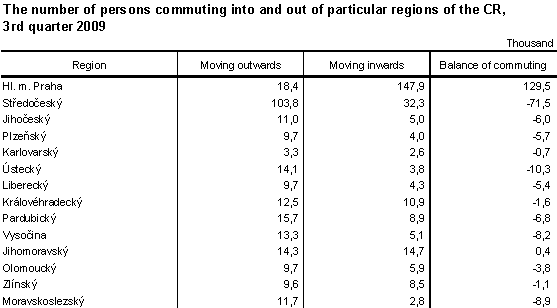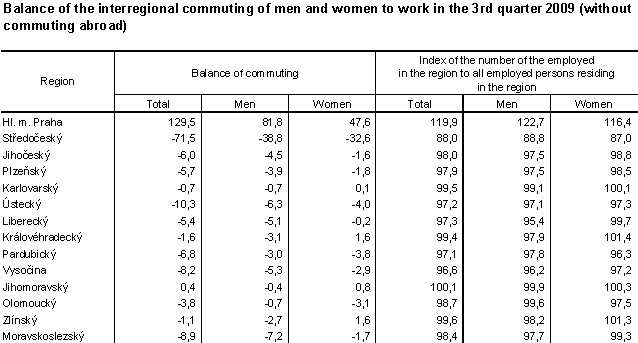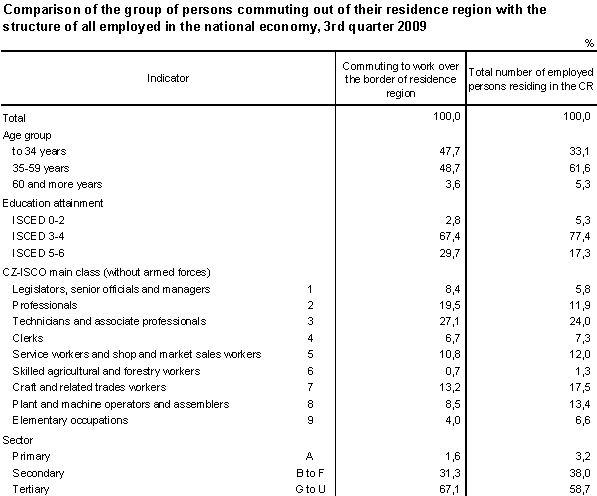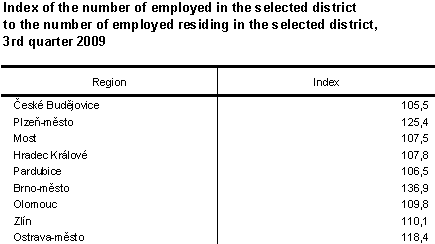Economic activity of the population - 3 quarter
07.11.2009
Code: q-3133-09
In the quarterly publications of the results of the Labour force sample survey (LFS), data documenting a different development of the employment in particular regions of the Republic are regularly indicated. These differences may be primarily regarded as a consequence of the different quantity and structure of job opportunities and consequently of the possibilities of the realisation of professional knowledge and skills.
Publicised data on regional employment relate to persons who have their customary domicile in the relevant region, no matter if they work really in that region. The sample survey makes possible, however, to gain more detailed data on the territorial localisation of the respondents’ work place and by comparing data on residing and working persons we can get a further notion of the volume of the commuting to work beyond border of the region (NUTS 3) of the respondents’ domicile. The LFS does not take account of the different frequency, but mostly the daily commuting is concerned, albeit the share of, for ex. the weekly or monthly commuting will be higher in this type of the movement to work, than it is in the intraregional or intradistrict commuting.
In the 3 rd quarter 2009, 256,6 thousand, i.e. 5,2 % of all employed persons residing on the territory of the CR were moving to work over the region border into other regions. This number does not include moving to work abroad. In spite of the relatively lower level of the total interregional commuting, the frequency of inward and outward commuting is in the view of particular regions very dissimilar. Very extraordinary in the position of Prague, to which 147,9 thousand persons i.e. almost 60 % of the group of commuting persons were moving. The second most frequent destination of the commuting to work is the Středočeský Region, namely with the total of 32,3 thousand (almost 13 % of the whole commuting). The commuting to other regions is markedly lower, 14,7 thousands persons were moving into the Jihomoravský Region and 10,9 thousand persons to the Královéhradecký Region. Moving to other regions differed from less than 3 thousand to Karlovarský Region to 9 thousand for Pardubický Region. Moreover we must respect the fact, that the reliability of the results of the sample survey, which are lower than 3 thousand, is lower.

The number of commuting to work outwards is in fact higher by cases of people working abroad. These employed persons, however, are only partially included in the survey in dwelling households, because in a lot of cases they cannot even be contacted. For this reason, such cases were not included. Since the LFS is carried out only in residential households and persons in the accommodation establishments are not object of the survey, also other categories on the CR territory, primarily foreigners, are only partially included. The chosen procedure, however, reflects reliably the interregional movement of persons who live in residential households and whose prevailing nationality is Czech.
From the directions of inward and outward commuting, the strength of the economic interaction of the economic factors between particular regions may be deduced. A by far strongest linkage is between Prague and the Středočeský Region. To Prague, 98,6 thousand persons, i.e. more than 38 % of the total commuting in the whole Republic, were moving from the Středočeský Region. In the inverse direction, more than 14,5 thousand persons were moving from Prague to Středočeský Region and the mutual commuting between these made up more than 44 % of the whole interregional commuting in the Republic. A more intensive movement to work in the capital is recorded also by the Jihočeský Region (7,8 thousand); moving to Prague from other regions varied from less 2 thousand out of the Liberecký and Karlovarský Regions to more than 5 thousand from the Jihomoravský Region. More than 4 thousand employed commuted from the Vysočina Region to the Jihomoravský Region, from Pardubický to Královéhradecký Region and vice versa from Královéhradecký to Pardubický Region and finally from the Liberecký to the Středočeský Region.
Prague is the only region of the Republic, where the number of the employed is markedly higher than the numbers of persons, who have their customary dwelling in Prague and have an employment. In all other regions except Jihomoravský, commuting outwards outweighed commuting inwards. The biggest difference was in the Středočeský Region, where a relatively high number of persons commuting in did not by far compensate the extraordinary commuting to work out of the region.

The group of persons commuting to work beyond the border of their residence region differs in a lot of factors from the total group of the employed in the Republic. The group of commuting in (or commuting out is essentially younger than that of all persons employed. Almost a half of them (48 %) was under 35 years, while the share of the same age group on the total employment was only one third. Most of the commuting out of their residence regions is people with the secondary education, i.e. with maturita examination or graduates from vocational schools. Their share, however, was only slightly higher than two thirds (over 67 %) of these employed persons, while persons with this education level shared in the total number of persons with the main job in the Republic by more than 77 %. This difference mirrors in the share of graduates of universities in both groups of employed persons, which are subject to comparison. While in the whole economy 17 % of employed persons were on the education level ISCED 5 and 6, in the group of people commuting to work out of their regions this share reached almost 30 % of all respondents. This is also documented by differences according to the criterion of their classification within the frame of CZ-NACE and CZ-ISCO-88 classifications. Besides the armed forces, an essentially more frequent commuting beyond the region border was recorded at persons belonging to the main classes of CZ-ISCO-88 1 – legislators, senior officials and managers, 2 – professionals and 3 – technicians and associate professionals. The share of all other ISCO main classes in this type of commutation is lower. This is also expressed by a higher share of commuting to work places belonging to the tertiary sector of services at the expense of the secondary sector of industry and construction.

From the results of the sample survey it is obvious, that the commuting into the capital markedly influences total data on the interregional commuting, primarily from the Středočeský Region. Last but not least, the movement between both regions is influenced by the fact, that that the number of inhabitants of the Středočeský regions is growing owing to the immigration of certain groups of people from the capital. The active net migration from Prague to Středočeský Region localities represents the strongest migration flow between all regions of the Czech Republic. Many inhabitants of the capital seek and find their residence in its upcountry and consequently boost the number of persons commuting to Prague. This group is characterized by a higher educational attainment with a corresponding share of qualified professions with an above-average income.
The size of the sample for the LFS does not allow to publish date on commuting on the district level. Despite this it is clear that more than half of persons commuting to Prague (almost 79 thousand) have their residence in districts Praha-východ, Praha-západ, Kladno, Kolín, Mělník and Benešov.
Interregional commuting represents of course a part of commuting to work out of the municipality of one’s residence. It includes neither frequent cases of the interdistrict commuting within the region, nor of the intradistrict commuting. To get an at least orientation assessment of the influence of commuting on the employment level in selected large districts, we can use again on the level NUTS 4 the index of the number of employed in the district to the number of employed residing in the district. In principle, it reflects the intensity of commuting in and out of the district within one’s own region including the balance of commuting from districts of other regions. In this view, the position of Prague is not so much exceptional. The index reaches the highest value in big cities like Plzeň (125,4) and mainly Brno (136,9), which means a higher level than in the case of the capital. Commuting to these cities comes mainly from the neighbouring and near districts Plzeň-jih, Plzeň-sever, Brno-venkov and Vyškov. A high value of the index is also observed in Ostrava-město. Even in some other districts with regional capitals like České Budějovice, Hradec Králové, Pardubice, Olomouc and Zlín we find the value of the index in the interval 106 – 110 points. In these cases, moreover, the index of commuting to regional capitals themselves is even higher than that of commuting to the whole districts, namely thanks to the commuting from municipalities of the sama district. Thus the regional capitals represent significant regional centres of commuting, which play a big role in the regional economics. A more detailed assessment of the structure of commutation on the base of the sample survey is on the NUTS 4 level not possible. It will be necessary to assess it only on the base of the results of the next census.

Contact: Information Services Unit - Headquarters, tel.: +420 274 056 789, email: infoservis@czso.cz










